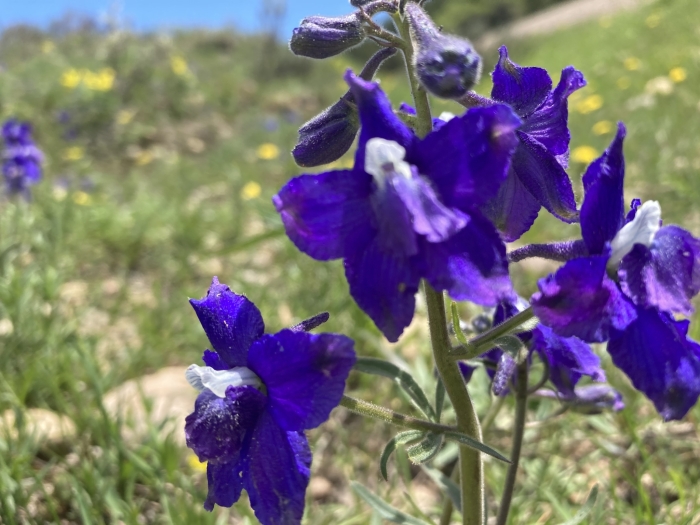Little Larkspur
(Delphinium bicolor)
Little Larkspur (Delphinium bicolor)
/
/

Caleb Catto
CC BY 4.0
Image By:
Caleb Catto
Recorded By:
Copyright:
CC BY 4.0
Copyright Notice:
Photo by: Caleb Catto | License Type: CC BY 4.0 | License URL: http://creativecommons.org/licenses/by/4.0/ | Rights Holder: Caleb Catto | Publisher: iNaturalist | Date Created: 2021-06-02T20:58:15Z |















































Estimated Native Range
Summary
Delphinium bicolor, commonly known as Little Larkspur, is a deciduous perennial herb that is native to open woodlands, grasslands, and meadows in the Northern United States and Canada. It is characterized by its thickly branching root system and typically grows to 40 centimeters (16 inches) in height. The stems are green with reddish bases, and most leaves are concentrated low on the stem, growing on short petioles. The inflorescence bears a few large flowers per stem, each with dark purple-blue sepals about 2 centimeters long and a spur that ranges from 1 to 2 centimeters. The flowers bloom in late spring to early summer and are moderately showy, attracting pollinators such as bees and butterflies.
Little Larkspur is valued for its vibrant flowers and compact size, making it suitable for rock gardens, borders, and wildflower meadows. It is also used in native plant gardens to support local ecosystems. While it prefers full sun to part shade, Little Larkspur is adaptable to various light conditions and requires medium amounts of water with well-drained soil. It is relatively low maintenance but should be handled with care due to its toxicity; all parts of the plant are poisonous if ingested, particularly to cattle. Gardeners should wear gloves when working with this plant to avoid skin irritation.CC BY-SA 4.0
Little Larkspur is valued for its vibrant flowers and compact size, making it suitable for rock gardens, borders, and wildflower meadows. It is also used in native plant gardens to support local ecosystems. While it prefers full sun to part shade, Little Larkspur is adaptable to various light conditions and requires medium amounts of water with well-drained soil. It is relatively low maintenance but should be handled with care due to its toxicity; all parts of the plant are poisonous if ingested, particularly to cattle. Gardeners should wear gloves when working with this plant to avoid skin irritation.CC BY-SA 4.0
Plant Description
- Plant Type: Herb
- Height: 1-2.5 feet
- Width: 0.8-1.4 feet
- Growth Rate: Moderate
- Flower Color: Blue, Purple
- Flowering Season: Spring, Summer
- Leaf Retention: Deciduous
Growth Requirements
- Sun: Full Sun, Part Shade
- Water: Medium
- Drainage: Medium
Common Uses
Bee Garden, Bird Garden, Butterfly Garden, Deer Resistant, Hummingbird Garden, Low Maintenance, Rabbit Resistant, Showy Flowers
Natural Habitat
Native to open woodlands, grasslands, and meadows in the Northern United States and Canada
Other Names
Common Names: Montana Larkspur, Flathead Larkspur, Low Larkspur, Dauphinelle Bicolore, Pied-D’Alouette Bicolore
Scientific Names: , Delphinium bicolor, Delphinium bicolor var. montanense, Delphinium helleri, Delphinium bicolor f. mccallae, Delphinium bicolor f. helleri, Delphinium bicolor f. montanense, Delphinium bicolor f. devriesii, Delphinium bicolor f. bicolor, Delphinium bicolor var. typicum
GBIF Accepted Name: Delphinium bicolor Nutt.